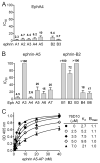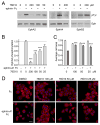A disalicylic acid-furanyl derivative inhibits ephrin binding to a subset of Eph receptors
- PMID: 21791013
- PMCID: PMC3196665
- DOI: 10.1111/j.1747-0285.2011.01199.x
A disalicylic acid-furanyl derivative inhibits ephrin binding to a subset of Eph receptors
Abstract
Eph receptor tyrosine kinases and ephrin ligands control many physiological and pathological processes, and molecules interfering with their interaction are useful probes to elucidate their complex biological functions. Moreover, targeting Eph receptors might enable new strategies to inhibit cancer progression and pathological angiogenesis as well as promote nerve regeneration. Because our previous work suggested the importance of the salicylic acid group in antagonistic small molecules targeting Eph receptors, we screened a series of salicylic acid derivatives to identify novel Eph receptor antagonists. This identified a disalicylic acid-furanyl derivative that inhibits ephrin-A5 binding to EphA4 with an IC(50) of 3 μm in ELISAs. This compound, which appears to bind to the ephrin-binding pocket of EphA4, also targets several other Eph receptors. Furthermore, it inhibits EphA2 and EphA4 tyrosine phosphorylation in cells stimulated with ephrin while not affecting phosphorylation of EphB2, which is not a target receptor. In endothelial cells, the disalicylic acid-furanyl derivative inhibits EphA2 phosphorylation in response to TNFα and capillary-like tube formation on Matrigel, two effects that depend on EphA2 interaction with endogenous ephrin-A1. These findings suggest that salicylic acid derivatives could be used as starting points to design new small molecule antagonists of Eph receptors.
© 2011 John Wiley & Sons A/S.
Figures






Similar articles
-
Inhibition of Eph receptor-ephrin ligand interaction by tea polyphenols.Pharmacol Res. 2012 Oct;66(4):363-73. doi: 10.1016/j.phrs.2012.05.010. Epub 2012 Jun 28. Pharmacol Res. 2012. PMID: 22750215 Free PMC article.
-
Eph receptors and ephrins as targets for cancer therapy.J Cell Mol Med. 2012 Dec;16(12):2894-909. doi: 10.1111/j.1582-4934.2012.01612.x. J Cell Mol Med. 2012. PMID: 22862837 Free PMC article. Review.
-
Lithocholic acid is an Eph-ephrin ligand interfering with Eph-kinase activation.PLoS One. 2011 Mar 30;6(3):e18128. doi: 10.1371/journal.pone.0018128. PLoS One. 2011. PMID: 21479221 Free PMC article.
-
Small molecules can selectively inhibit ephrin binding to the EphA4 and EphA2 receptors.J Biol Chem. 2008 Oct 24;283(43):29461-72. doi: 10.1074/jbc.M804103200. Epub 2008 Aug 26. J Biol Chem. 2008. PMID: 18728010 Free PMC article.
-
Targeting Eph receptors with peptides and small molecules: progress and challenges.Semin Cell Dev Biol. 2012 Feb;23(1):51-7. doi: 10.1016/j.semcdb.2011.10.023. Epub 2011 Oct 25. Semin Cell Dev Biol. 2012. PMID: 22044885 Free PMC article. Review.
Cited by
-
Inhibition of Eph receptor-ephrin ligand interaction by tea polyphenols.Pharmacol Res. 2012 Oct;66(4):363-73. doi: 10.1016/j.phrs.2012.05.010. Epub 2012 Jun 28. Pharmacol Res. 2012. PMID: 22750215 Free PMC article.
-
Unique structure and dynamics of the EphA5 ligand binding domain mediate its binding specificity as revealed by X-ray crystallography, NMR and MD simulations.PLoS One. 2013 Sep 24;8(9):e74040. doi: 10.1371/journal.pone.0074040. eCollection 2013. PLoS One. 2013. PMID: 24086308 Free PMC article.
-
The Role of Ephs and Ephrins in Memory Formation.Int J Neuropsychopharmacol. 2016 Apr 20;19(4):pyv106. doi: 10.1093/ijnp/pyv106. Print 2016 Apr. Int J Neuropsychopharmacol. 2016. PMID: 26371183 Free PMC article. Review.
-
Eph receptors and ephrins as targets for cancer therapy.J Cell Mol Med. 2012 Dec;16(12):2894-909. doi: 10.1111/j.1582-4934.2012.01612.x. J Cell Mol Med. 2012. PMID: 22862837 Free PMC article. Review.
-
Targeting EphA2 in cancer.J Hematol Oncol. 2020 Aug 18;13(1):114. doi: 10.1186/s13045-020-00944-9. J Hematol Oncol. 2020. PMID: 32811512 Free PMC article. Review.
References
-
- Pasquale EB. Eph receptor signalling casts a wide net on cell behaviour. Nat Rev Mol Cell Biol. 2005;6:462–75. - PubMed
-
- Pasquale EB. Eph-ephrin promiscuity is now crystal clear. Nat Neurosci; 2004;7:417–8. - PubMed
-
- Jorgensen C, Sherman A, Chen GI, Pasculescu A, Poliakov A, Hsiung M, et al. Cell-specific information processing in segregating populations of Eph receptor ephrin-expressing cells. Science; 2009;326:1502–9. - PubMed
-
- Ireton RC, Chen J. EphA2 receptor tyrosine kinase as a promising target for cancer therapeutics. Curr Cancer Drug Targets; 2005;5:149–57. - PubMed
Publication types
MeSH terms
Substances
Grants and funding
LinkOut - more resources
Full Text Sources
Other Literature Sources
Chemical Information
Miscellaneous

